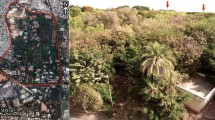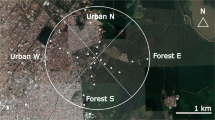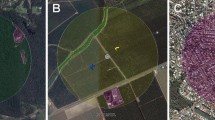Abstract
Compared to our extensive knowledge about the navigation and homing abilities of ants and bees, we know rather little about these phenomena in social wasps. Here, we report the homing abilities of the tropical primitively eusocial wasp Ropalidia marginata and the factors that affect their homing success. To determine from how far these wasps can return to their nests, we transported foragers blindfold and released them at gradually increasing distances from their nests in four cardinal directions. Their homing success was determined by checking their presence on their nests on three consecutive nights. All foragers (56 individuals, 115 releases) returned back from an area of 0.73 ± 0.25 km2 on the day of release (minimal homing area), whereas 83.8 % of the foragers (217 individuals, 420 releases) returned when we enlarged the area of release to 6.22 ± 0.66 km2 around their nests (maximal homing area). Of 66 releases, no wasps returned from beyond the maximal homing area. The minimal homing area might be familiar to the foragers because they probably routinely forage in this area and the maximal homing area represents the maximum distances from which the wasps are capable of returning to their nests, with or without familiarity.




Similar content being viewed by others
References
Bang A, Gadagkar R (2012) Reproductive queue without overt conflict in the primitively eusocial wasp Ropalidia marginata. Proc Nat Acad Sci 109:14494–14499. doi:10.1073/pnas.1212698109
Burt WH (1943) Territoriality and home range concepts as applied to mammals. J Mammal 24:346–352
Carbone C, Cowlishaw G, Isaac NJB, Rowcliffe JM (2005) How far do animals go? Determinants of day range in mammals. Am Nat 165:290–297
Cheng K (2006) Arthropod navigation: ants, bees, crabs, spiders finding their way. In: Wasserman EA, Zentall TR (eds) Comparative cognition: experimental explorations of animal intelligence. Oxford University Press, Oxford, pp 189–209
Chmurzyński JA, Kieruzel M, Krzysztofiak A, Krzysztofiak L (1998) Long-distance homing ability in Dasypoda altercator (Hymenoptera, Melittidae). Ethology 104(5):421–429
Cresswell JE, Osborne JL, Goulson D (2000) An economic model of the limits to foraging range in central place foragers with numerical solutions for bumblebees. Ecol Entomol 25:249–255
Dyer FC (1998) Spatial cognition: lessons from central-place foraging insects. In: Balda RP, Pepperberg IM, Kamil AC (eds) Animal cognition in nature: the convergence of psychology and biology in laboratory and field. Academic Press, California, pp 119–154
Fabre JH (1914) The mason bees. Dodd, Mead and Company, New York
Gadagkar R (2001) The social biology of Ropalidia marginata: toward understanding the evolution of eusociality. Harvard University Press, Cambridge
Gathmann A, Tscharntke T (2002) Foraging ranges of solitary bees. J Anim Ecol 71(5):757–764
Goulson D, Stout JC (2001) Homing ability of the bumblebee Bombus terrestris (Hymenoptera: Apidae). Apidologie 32:105–111
Greenleaf SS, Williams NM, Winfree R, Kremen C (2007) Bee foraging ranges and their relationship to body size. Oecologia 153:589–596
Howard KJ, Jeanne RL (2004) Rates of brood development in a social wasp: effects of colony size and parasite infection. Insectes Soc 51:179–185
Hyane DW (1949) Calculation of size of home range. J Mammal 30:1–18
Kimeldorf GS, Wahba G (1970) A correspondence between Bayesian estimation on stochastic processes and smoothing by splines. Ann Math Stat 41:495–502
Osborne JL, Martin AP, Carreck NL, Swain JL, Knight ME, Goulson D, Hale RJ, Sanderson RA (2008) Bumblebee flight distances in relation to the forage landscape. J Anim Ecol 77:406–415
Pahl M, Zhu H, Tautz J, Zhang S (2011) Large scale homing in honeybees. PLoS One 6(5):e19669. doi:10.1371/journal.pone.0019669
Papi F (1992) General aspects. In: Papi F (ed) Animal homing. Chapman and Hall, London, pp 5–6
Potts JR, Harris S, Giuggioli L (2012) Territorial dynamics and stable home range formation for central place foragers. PLoS One 7(3):e34033. doi:10.1371/journal.pone.0034033
Powell RA (2000) Animal home ranges and territories and home range estimators. In: Boitani L, Fuller T (eds) Research techniques in animal ecology: controversies and consequences. Columbia University Press, New York, pp 65–110
Rau P, Rau N (1918) Wasps studies afield. Princeton University Press, Princeton
Roubik DW, Aluja M (1983) Flight ranges of Melipona and Trigona in tropical forest. J Kans Entomol Soc 56:217–222
R Core Team (2013) R: a language and environment for statistical computing. R foundation for statistical computing, Vienna, Austria. ISBN 3-900051-07-0. http://www.R-project.org/
Ugolini A, Cannicci S (1996) Homing in paper-wasps. In: Turillazzi S, West-Eberhard MJ (eds) Natural history and evolution of paper-wasps. Oxford University Press, Oxford, pp 126–143
Visscher PK, Seeley TD (1982) Foraging strategy of honeybee colonies in a temperate deciduous forest. Ecology 63:1790–1801
Wehner R (1981) Spatial vision in arthropods. In: Autrum H (ed) Handbook of sensory physiology, vol VII/6c. Springer, Berlin, pp 287–616
Wystrach A, Graham P (2012) What can we learn from studies of insect navigation? Anim Behav 84:13–20
Zar JH (2009) Biostatistical analysis, 4th edn. Dorling Kindersley Publishing Inc., London, pp 141–145
Zeil J (2012) Visual homing: an insect perspective. Curr Opin Neurobiol 22:285–293. doi:10.1016/j.conb.2011.12.008
Zurbuchen A, Landert L, Klaiber J, Müller A, Hein S, Dorn S (2010) Maximum foraging ranges in solitary bees: only few individuals have the capability to cover long foraging distances. Biol Conserv 143:669–676
Acknowledgments
We thank the Department of Science and Technology, the Department of Biotechnology, and the Ministry of Environment and Forests, Government of India for financial assistance. SM and RG designed the study, SM conducted the study and RG and SM cowrote the paper. We thank Sandeep Pulla, for suggesting the use of cubic spline to draw the boundaries of the homing areas and Anjan Nandi for guidance in data analysis and both for their comments on the manuscript. All experiments reported here comply with the current laws of the country in which they were performed. This article does not contain any studies with human participants performed by any of the authors. The authors declare that they have no conflict of interest.
Author information
Authors and Affiliations
Corresponding author
Electronic supplementary material
Below is the link to the electronic supplementary material.
Rights and permissions
About this article
Cite this article
Mandal, S., Gadagkar, R. Homing abilities of the tropical primitively eusocial paper wasp Ropalidia marginata . J Comp Physiol A 201, 795–802 (2015). https://doi.org/10.1007/s00359-015-1019-2
Received:
Revised:
Accepted:
Published:
Issue Date:
DOI: https://doi.org/10.1007/s00359-015-1019-2




